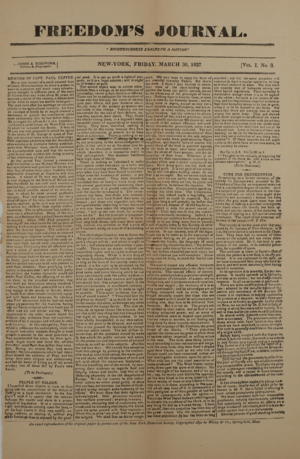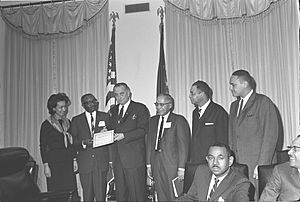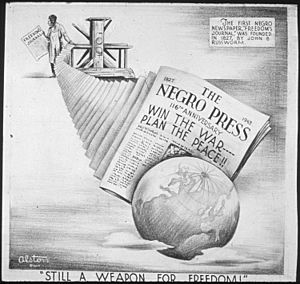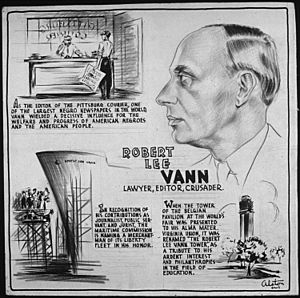African-American newspapers facts for kids

African-American newspapers are news publications in the United States that serve African-American communities. They are also known as the Black press or Black newspapers.
The very first African-American newspaper was Freedom's Journal. It was started in 1827 by Samuel Cornish and John Brown Russwurm. Before the American Civil War, other important newspapers began. One famous example is The North Star, which Frederick Douglass founded in 1847.
As African Americans moved to big cities, almost every city with many Black residents soon had newspapers just for them. These newspapers also became popular outside of African-American communities. Today, like many newspapers, Black newspapers have faced challenges. Many have closed, merged, or become smaller. This is because the internet now offers free news and cheap advertising.
Contents
A Look Back in Time
How It All Started
Most early African-American newspapers, like Freedom's Journal, were printed in the North. They were then secretly sent to African Americans across the country. By the 1900s, daily newspapers for Black communities appeared in cities like Norfolk, Chicago, Baltimore, and Washington, D.C..
The 1800s: A Time of Growth
Many important Black newspapers came out in the 1800s. Some of these included:
- Freedom's Journal (1827–1829)
- Philip Alexander Bell's Colored American (1837–1841)
- The North Star (1847–1860)
- National Era
- Frederick Douglass' Paper (1851–1863)
- Douglass Monthly (1859–1863)
- The People's Advocate (1876–1891)
- The Christian Recorder (1861–1902)
In the 1860s, newspapers like The Elevator and the Pacific Appeal started in California. This happened because Black people took part in the Gold Rush.
In 1885, Daniel Rudd created the Ohio Tribune. It was said to be the first newspaper "printed by and for Black Americans". He later made it into the American Catholic Tribune. This was believed to be the first Black-owned national newspaper.
The American Freedman was a newspaper based in New York. It aimed to inspire African Americans to use the Reconstruction period for social and political progress. It did this by sharing stories of Black community efforts that had support from both local and global communities.
Many African-American newspapers faced challenges. It was hard to keep them running because many African Americans could not read. Also, many freed African Americans had low incomes. They could not afford to buy subscriptions. Instead, they often shared copies with each other.
In 1890, the National Afro-American Press Association was formed in Indianapolis.
The 1900s: A Flourishing Era
African-American newspapers grew very quickly in major cities. Their publishers became very important in politics and business. Some key leaders included:
- Robert Sengstacke Abbott (1870–1940), who published the Chicago Defender
- John H. Sengstacke (1912–1997), also from the Chicago Defender
- John Mitchell Jr. (1863–1929), editor of the Richmond Planet
- Anthony Overton (1865–1946), publisher of the Chicago Bee
- Garth C. Reeves Sr. (1919–2019), publisher of the Miami Times
- Robert Lee Vann (1879–1940), publisher and editor of the Pittsburgh Courier
Between 1940 and 1949, the number of Black newspapers grew from 150 to 250.
From 1881 to 1909, the National Colored Press Association worked as a group for newspaper businesses. Later, the National Negro Business League's National Negro Press Association took over this role from 1909 to 1939. The Chicago-based Associated Negro Press (1919–1964) was a news service. It had reporters in all major Black communities. In 1940, John H. Sengstacke helped Black newspaper publishers form a new group. Today, it is known as the National Newspaper Publishers Association.

During the 1930s and 1940s, Black newspapers in the South helped the movement for equal pay for Black teachers. Newspaper stories helped to spread the word about this important cause.
There were also many special Black publications. For example, those by Marcus Garvey and John H. Johnson. These people helped Black voices be heard in society. The Roanoke Tribune was started in 1939 by Fleming Alexander. It recently celebrated its 75th anniversary. The Minnesota Spokesman-Recorder is Minnesota's oldest Black newspaper. It is one of the oldest ongoing minority publications in the United States.
The 2000s: The Digital Age
Many Black newspapers that started in the 1960s, 1970s, and 1980s closed down. They could not get enough advertising. They were also victims of their own success in fighting racism and promoting civil rights. As of 2002, about 200 Black newspapers were still publishing.
With fewer people reading print newspapers, and more people using the internet, many Black news websites appeared. Some well-known ones include Black Voice News, The Grio, The Root, and Black Voices.
See also
- African-American businesses
- List of African-American newspapers and media outlets
- List of newspapers in the United States



